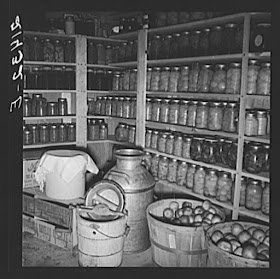 |
| Chutney from Pinterest |
Chutney and a variety of vegetable combos called things like: relishes, conserve, honey, butter, salsa, spread and piccalilli are all good stuff. Most were served in a small glass bowl to be passed at the table. They're really good on meat. Most were not mixed into other dishes.
Here's a good chutney for using tomatoes:
Ripe Tomato Chutney
1 pound - Ripe tomatoes - skin and core
8 ounces - Onions - skin
4 ounces - Sour applies - peel and core
1 pound - Raisins
4 ounces - Light brown sugar, packed
1/4 ounce - Salt
1/4 ounce - Ground ginger
Pinch - Cayenne pepper
1/2 pint - Vinegar
Chop tomatoes, onions, apples and raisins. Spray heavy cooking pan with PAM. Add all ingredients and boil to a rather lumpy mash. Stir to keep from sticking. This will take one hour or more. Ladle into hot sterilized jars, cap and process for 15 minutes. Makes 1 1/2 pound.
From "The Farmhouse Kitchen" by Mary Norwak.
Good General Information
Chutney is typically a sweet/sour combo with lumps. It almost always has raisins or sultanas and ginger. It always has sugar and vinegar. Although there are many fruit chutney recipes, ones with ripe or green tomatoes are many.
The combination of fruits and vegetables in old recipes are often those things ripening at the same time. In this recipe, it's tomatoes and apples.
Many recipes for preserving contain spices. Today it's used to flavor. Originally it was used as a way to disguise bad tasting mostly spoiled food. You know our ancestors were the top of the health gene line because they survived the Middle Ages without death due to food poisoning.
Food preservation by water bath or pressure cooker canning hasn't been around that long. The first canning methods simply put hot food in the clean hot jars, capped and hoped for the best. Jellies and similar sweet products had a layer of melted wax on top. Some meats had layers of fat poured over them in a crock. Some pickled items would keep for months in crocks.
The reason for root cellars was the temperature was cool all year and was used to keep unpreserved food from spoiling especially apples, pears, potatoes and some other root vegetables. For those things that wouldn't keep, you ate or you preserved. Jars of preserved foods were also kept in cool dark places to prolong the shelf life and keep the color. Preserved food in glass jars may look beautiful sitting on your kitchen shelves but the heat will cause it to loose it's looks and nutritional value much faster.
 |
| Great example of an early root cellar. If your old house has similar shelves in the basement, you can pretty much be assured it was once stocked like this cellar. |
No comments:
Post a Comment